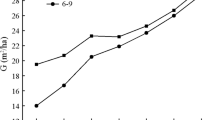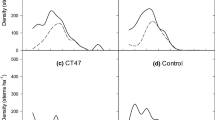Summary
The present article deals with the response ofP. deltoides to thinning. In 1965 an experiment was laid out in an 8-year old poplar plantation, site class, 0.5 in the mist belt of Natal. The S% defined as the ratio mean distance between the trees mean height of the stand = 100 was used to express stand density and to characterize the degree of thinning. Three thinning degrees, designated as A, B and C, with an S% of 24,31 and 36 respectively, were tested in a completely randomized design wth four replications. The plot areas were 0.144 hectare and each plot was surrounded by a 5.4 m. wide buffer zone.
In 1965, immediately after the thinning of the plots, the mean basal areas per hectare of the A, B and C plots were: A: 23.0 m2(= 100) B: 15.5 m2(= 66) C: 11.3 (= 49)
The relationship between basal area at the beginning of the growing season and the basal area increment during the first growing season was expressed by the equation: basal area increment (m2/hect./annum) = -10.417+21.9258 (log basal area) - 8.3256 (log basal area)2 the multiple correlation coefficient being equal to 0.860. During the second growing season there was a weakly significant negative correlation between basal area and basal area increment. During the third year stand density and growth were not related.
An analysis of the relationship between periodic current volume growth during the 3-year growth period and the mean stand density during this period, the latter defined as the average of the stand densities at the beginning and end of the period, revealed that basal area is more suitable to express stand density than S%. In the regression analysis, the residual variation with S% as explanatory variable was 8.3% of the total variation, as against 2.0% with mean basal area as explanatory variable.
There was a linear relationship between basal area and periodic current volume increment. For a mean basal area during the growth period of 28.0 m2 per hectare, the annual volume increment was 49 m3, for a basal area of 14 m2, it was 35.5% below this maximum. During the third growing season the A-plots reached the “natural stocking density”, defined as the maximum basal area which the stand can carry on a certain site and at a given age. In the financial calculations, the indicating per cent was defined as:
where: Ax, Ax+n = net-value of the stand at x, x+n years n = length of period in years V = capitalized annual general cost Hkx, Hkx+n = cost value of stand at x, x+n years B = market value of land p = rate of interest.
The indicating per cent as calculated for each of the 12 plots and the following equation fitted: Ind.% = -2.25 + 1.967 (mean basal area) - 0.04498 (mean basal area)2
The optimum basal area therefore was 22 m2 per hectare, i.e. 71-73% of the natural stocking density.
Similar content being viewed by others
Literatur
Assmann, E., 1961: Waldertragskunde.
Assmann, E., 1961: Über die Brauchbarkeit des Verfahrens vonHart-Becking zur Festlegung der Durchforstungsstärke. Forstw. Cbl. 80, 352–355.
Assmann, E., 1964: Der Fichten-Durchforstungsversuch Bowmont. Allg. F. u. J.-Z. 213–226.
Assmann, E., 1964: Empfehlungen für neue Durchforstungsversuche. Allg. F. u. J.-Z. 96–102.
Assmann, E., 1968: Zur „Theorie der Grundflächenhaltung”. Forstw. Cbl.87, 321–330.
Baten, W. D., 1941: How to determine which of two variables is better for predicting a third variable. J. of the Amer. Soc. of Agr.33, 695–699.
Becking, J. H., 1961: Über die Brauchbarkeit des Verfahrens vonHart-Becking zum Festlegen der Durchforstungsstärke Forstw. Cbl.80, 236–240.
Bradley, R. T., Christie, J. M., andJohnston, D. R., 1966: Forest Management tables.
Crocoll, 1957: Ertragstafel für P. marilandica und P. robusta (aus:Wiedemann-Schober: Ertragstafeln wichtiger Holzarten).
Hart, H. M. J., 1928: Stamtal en dunning. Meded. Proefst. v. h. Boschwezen.
Henriksen, H. A., 1951: Révision d'une expérience de coupes d'éclaircies de hêtre dans les forêts de la municipalité de Arhus. Det forstl. Forsøsv. i Danmark, Nr. 166.
Kennel, R., 1966: Soziale Stellung, Nachbarschaft und Zuwachs. Forstw. Cbl.85, 193–204.
Laar, A. van, 1970: Influence of tree parameters and stand density on diameter growth of Pinus radiata. S. A. For. Journal (im Druck).
Matern, B., 1960–61: Spatial variation. Stochastic models and their application to some problems in forest surveys and other sampling investigations. Medd. Stat. Skogsf. Anst.49, 5.
Prevôsto, M., 1965: Das Wachstum der euamerikanischen Pappel I-214 auf verschiedenen Standorten der Lombardisch-Piemonter Ebene in Abhängigkeit von der Verbandsweite und von der Umtriebszeit. Publ. dell'ente Naz. per la cell. e per la carta, Roma.
Schober, R., 1964: Gedanken und Vorschläge zu einer Anleitung für Durchforstungsversuche und einem Baumklassensystem. Allg. F. u. J.-Z. 87–95.
Schober, R., 1969: Massen- und Wertleistung der Douglasie bei verschiedener Durchforstung, dargelegt am Beispiel vonWiedemanns Versuchsreihe im Forstamt Daun-Ost 44/45. Allg. F. u. J.-Z. 145 bis 157.
Snedecor, G., andCochran, W. G., 1967: Statistical methods.
Speidel, G., 1967: Forstliche Betriebswirtschaftslehre.
Tingle, A. C., 1966: Silviculture, volume and yield of P. deltoides. Ann. Univ. Stellenbosch Bd.41.
Ward, W. W., 1964: Live crown ratio and stand density in young even-aged red oak stands. For. Sc. 56–65.
Author information
Authors and Affiliations
Rights and permissions
About this article
Cite this article
van Laar, A. Vorläufige Ergebnisse eines Pappel-Durchforstungs-Versuches in Südafrika. Forstw Cbl 89, 141–152 (1970). https://doi.org/10.1007/BF02740947
Published:
Issue Date:
DOI: https://doi.org/10.1007/BF02740947




